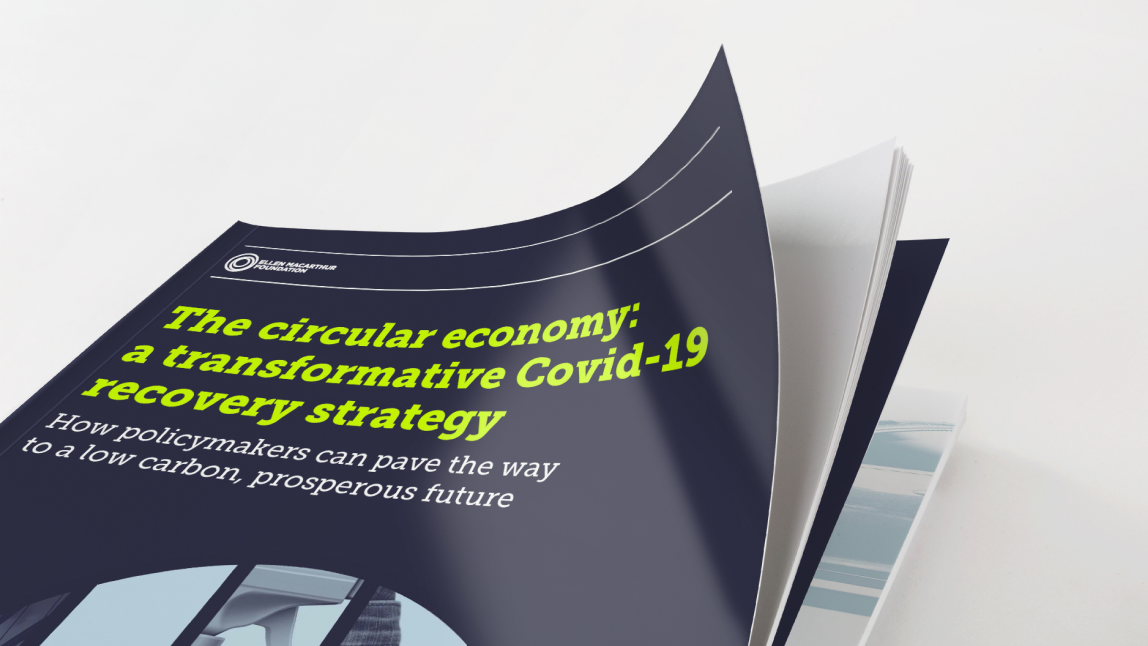Shaping incentives to enable a circular, low-carbon economy
As economies restart, there is an opportunity to restructure SME and wider business support schemes towards long-term resilience. The dramatic and sudden loss of demand and revenue that followed the pandemic has caused many businesses, especially SMEs, to face severe liquidity shortages. Public financial support will therefore be essential to help SMEs bounce back or even survive the impacts of the pandemic. While policymakers in the EU, in response to this challenge, have increased budgets for direct public support mechanisms and SME subsidies, many of these tend to only focus on short-term liquidity needs. However, to shape a stronger and more resilient long-term recovery, there is an opportunity to restructure SME schemes. For example, schemes could be provided that help businesses implement circular economy principles to improve their competitiveness and environmental performance, leverage digital technologies, achieve inclusivity, and strengthen their resilience against future shocks. The pandemic has also shown the importance of local value chains, while reliance on stretched international supply chains is now being perceived as riskier. Governments therefore also have a role to play in supporting businesses that offer more localised, diversified, and distributed production—through repairrepairOperation by which a faulty or broken product or component is returned back to a usable state to fulfil its intended use., refurbishment, remanufacturing, and local production—as they can help pave the way towards a more resilient future that enhances the economic development of communities. In achieving these cross-cutting objectives, the circular economycircular economyA systems solution framework that tackles global challenges like climate change, biodiversity loss, waste, and pollution. It is based on three principles, driven by design: eliminate waste and pollution, circulate products and materials (at their highest value), and regenerate nature. acts as a key delivery framework.
When it comes to larger businesses, governments can also help guide the transition to a cleaner and more resilient recovery by attaching conditions within, for example, stimulus packages, state aid, and bailout funds. This can help increase the uptake of certain practices or technologies that contribute to a better recovery. In Austria, for example, the government has asked airlines to commit to reducing carbon emissions as a condition for its support, and in France, a EUR 7 billion package of state-guaranteed loans for Air France, in which the government is a shareholder, comes with the requirement that the airline reduces domestic CO2 emissions by 50% by 2024.
The tax system is a powerful tool to shape economic activity and combat systemic issues that long predated the Covid-19 pandemic, providing a conducive environment for a circular economy. Since the onset of the pandemic, fiscal packages have been aimed at cushioning the immediate impact of the sudden drop in economic activity. The current crisis also presents governments with an opportunity to shape, for the long-term, a more prosperous economic recovery that also meets environmental objectives. In particular, the OECD stresses that lowering taxes on labour and capital, in favour of taxing environmentally harmful consumption and production, can play an important role in stimulating job creation and investment. It is this shift of taxes that could play an instrumental role not only in the valorisation of resources, but also in the stimulation of labour intensive circular business models such as R&D, repair, maintenance, and recycling. To give an indication of the benefit, a study on Finland showed that over the course of seven years (2019-2025), reducing labour taxes, increasing environmentally related taxes, and phasing out environmentally harmful subsidies could reduce carbon emissions by 8.4 million tonnes, save EUR 924 million on energy import bills, as well as add 115,600 person years of employment and EUR 12.9 billion in GDP. Another study has also shown that cuts in taxes on labour income may even outperform other stimulus plans in promoting job creation for those who lost their jobs in the Covid-19 downturn, i.e. jobs that are care-orientated (such as retail trade, hospitality, social work) and involve manual labour (such as construction, manufacturing, maintenance). With these benefits in mind, The Ex’tax Project—a think tank striving for a fundamental tax shift from labour to natural resource use and consumption—has now started a new research project on fiscal innovation and reform, with the ultimate aim of offering a perspective on putting the Netherlands, and ultimately the European Union, on a pathway towards a green and inclusive recovery.
In addition, specific fiscal support can also play a vital role in stimulating innovation and incentivising circular economy practices. Reducing taxes such as value added taxes on reusereuseThe repeated use of a product or component for its intended purpose without significant modification., repair, and remanufacturing activities can incentivise circular designs and business models and support the circulation of valuable goods, materials, and nutrients. Other fiscal measures can increase the use of secondary materials and encourage the adoption of regenerative food production. While these instruments are increasingly being put in place, more will be needed to help accelerate the transition.
To pave the way towards a low-carbon Covid-19 recovery, the OECD has emphasised that both the removal of fuel subsidies and the introduction of long-term carbon pricing will be needed to help align price signals with green stimulus packages. While the pandemic may have derailed carbon reduction plans, the need to decarbonise the economy remains as urgent as ever. The prevailing economic and financial frameworks are hardwired for and by the linear economylinear economyAn economy in which finite resources are extracted to make products that are used - generally not to their full potential - and then thrown away ('take-make-waste')., and the cost of inaction on tackling emissions could amount to USD 600 trillion by the end of the century. A circular economy can help meet global climate targets by transforming the way we produce and use goods. Relying solely on energy efficiency and switching to renewable energyrenewable energyEnergy derived from resources that are not depleted on timescales relevant to the economy, i.e. not geological timescales. will only address 55% of global greenhouse gas (GHG) emissions. By adopting circular practices, the remaining 45% can be tackled. However, companies seeking out circular economy opportunities that help shape a low-carbon economic recovery, can face multiple market failures including unpriced negative externalities, transaction costs, split incentives, imperfect information, insufficient public goods or infrastructure, and insufficient competition. Unpriced negative externalities often take place across virgin material extraction, product use, and disposal which do not reflect their full associated environmental and societal costs. This is particularly apparent with fossil fuels with, for example, the fuel used in international aviation and maritime transport being generally exempt from carbon pricing initiatives. However, pricing negative externalities can help level the playing field and scale the circular economy.
In addition, policymakers can also use subsidies, especially in times of crisis, to promote future areas of growth and employment, and incentivise producers to minimise their resource dependency by exploring circular opportunities. As an example, subsidies that are environmentally harmful should be phased out as these could hinder a swift transition to a circular economy and the tackling of challenges such as climate change. Actions to this effect are already being taken in some places, as evidenced by Nigeria’s decision to end subsidies for fossil fuel consumption. Unfortunately, these measures are not yet commonplace as today, much of the subsidies still go towards unsustainable production systems. When it comes to energy, for example, more than twice the amount of subsidies are going to fossil fuels (USD 478 billion in 2019) compared to renewables.
However, the OECD, after reflecting on the lessons learned from past green stimulus packages, has observed that it is only by combining the removal of environmentally harmful subsidies with the pricing of negative externalities, that such measures can help accelerate a carbon-neutral recovery, and improve resilience to future shocks from climate change.
“The key point is not that climate change will be disastrous. The key point is that, if we learn the lessons of Covid-19, we can approach climate change more informed about the consequences of inaction, and more prepared to save lives and prevent the worst possible outcome. The current global crisis can inform our response to the next one.”












